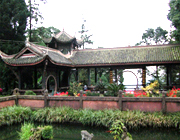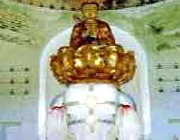Wannian Temple
The Wannian Temple is one of the major temples on Emei Mountain, originally called "Puxian (Samantabhadra) Temple", established in 401A.D. by Monk Mingche. In 876A.D. it was reconstructed and renamed as "Baishui Puxian Temple". In 979A.D. the abbot of the temple, Monk Maozhen was awarded by Emperor Taizong, Zhao Guangyi. The emperor sent a high-ranking official, Zhang Renzan, to accompany Monk Maozhen back to Chengdu City, taking 3,000 teals of gold with him. Using the gold, they bought 300,000 jin (15 tons) copper to cast a statue of Puxian (Samantabhadra Bodhisattva) riding a white elephant, 8.5 meters high and weighing an estimated 62,000 kilos. The statue is proportioned properly and modeled elegantly, being a representative of the art of foundry of the Song Dynasty (960-1279). 
In order to make the building fire-proof, people adopted the architectural techniques and style of India and Burma: the whole main hall had neither beam nor post, not a single piece of wood was used, and thus, it was also called "Beamless Hall". There are four  colored "Flying Asparases" on the vault. The lines are so elegant and free as if dancing in the sky. On the dome are five steeples and some decorations such as the lion, deer and so on, showing a very chic style.
colored "Flying Asparases" on the vault. The lines are so elegant and free as if dancing in the sky. On the dome are five steeples and some decorations such as the lion, deer and so on, showing a very chic style.
Now, of 10,000 years, the temple is the oldest surviving Emei monastery.